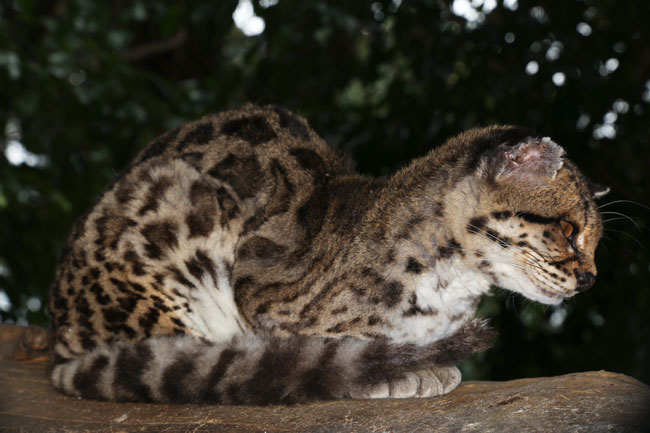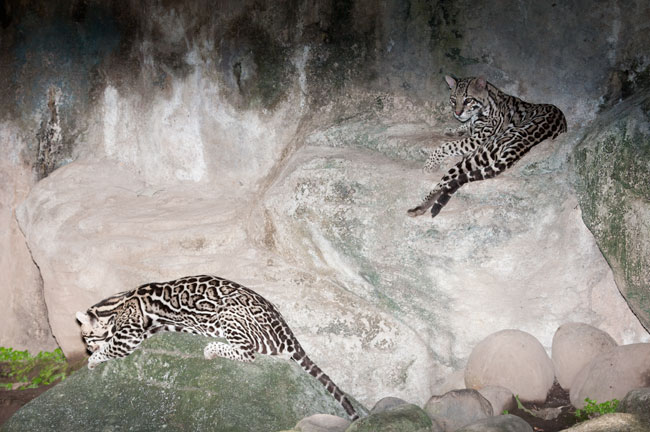Margay vs Ocelot
The margay is a tad larger than an ocelot, and not as long as a jaguarundi. Think of the margay as sort of a baby leopard (the scientific name for margay, Leopardus wiedii, suggests the two animals are distantly related). But there are no leopards in Guatemala, and no panthers either.
The so called black panther of Mexico, Guatemala and Belize is simply a normal jaguar whose DNA causes it to be either solid black, or black but with barely visible spots, or gray with more easily visible spots. But even if “solid black” you can still see the spots if you know they are there.
Margay, Leopardus wiedii, can be seen on the national Guatemalan zoo, La Aurora.
Margay, Leopardus wiedii, in Guatemala (and Belize, Mexico, Honduras, etc)
Margays are well adapted for climbing. A jaguar can also climb a tree, but you are more likely to find the jaguars and pumas walking along their trails.
Why do we study felines, especially margay, ocelot, and jaguar?
The Classic Maya a thousand years ago made decorations of feline hides. Kings wore jaguar costumes; rulers sat on jaguar hides spread out over their thrones (sadly jaguars were slaughtered for their hides for thousands of years).
Plus many vases, bowls, and other artifacts are decorated with painted and/or incised representations of feline spots. Sadly, most Mayanists who label these, call them all “jaguar spots”, automatically. They do not realize that margay spots, ocelot spots, and rosettes of jaguars, may be different.
Yes, of course, some spots in different parts of an ocelot or margay may be vaguely similar to one or two spot areas of a jaguar. This is because each part of a jaguar body has a different spot pattern.
So we photograph margays, ocelots, and jaguars in order to remind iconographers, epigraphers, and archaeologists to be cautious about assuming that all spots on Maya pottery are “jaguar” spots.
Of course there are also generic feline spot patterns rendered by Maya artists. These could well be a quick generic mimicry of an actual jaguar.
Leopardus pardalis, can be seen on the Auto Safari Chapin, Escuintla - Guatemala.
How to do digital photography of a Margay?
First, we thank the director and staff of the main zoo of Guatemala City, Parque Zoológico La Aurora. They astutely suggested we not do photography inside the cage of the jaguar or of the pumas (we followed their advice). We also do not enter cages of jaguarundi, since they are always nervously walking back and forth all day (even when there are not people near their area).
But the margays, ocelots, red foxes and comparable sized animals view us as entertainment when we enter their cages. To get good photos it helps to have close-ups. And most importantly, we don’t want to have the metal bars or fence mesh in the photo!
Of course you could also send several months in the forests and set up cameras with laser triggers, but that takes months (not to mention the substantial costs). Plus if your camera is taking automatic photos, you can’t compose or do close-ups. Guatemala is not like a safari country: I have been here over 50 years, and lived in the remote rain forests for five years, but have never seen an ocelot or margay more than once.
First, avoid using a large flash. The flash will turn the feline eyes into zombie eyes (plus the flash may irritate the margay). But since you probably need lighting in a cage (since it has a roof to keep out the sun, we suggest a ring light. These are soft lights. The next time we are photographing these felines, or red foxes or comparable animals we will try a Rosco LitePad Loop. Just realize this is a deliberately weak light, and not functional more than 30 cm away. Even at one meter distance would probably not provide much extra light.
If you need lots of lighting, in ring light format, try an AlienBees ABR800 Ringflash Unit or Elinchrom1500 Ringflash. We have not yet tested either of these. We use the Metz Mecablitz 15 MS-1.
Margays as pets?
The general consensus is not to have endangered species as pets, because to get a pet a hunter tends to kill the mother (to capture the baby). But occasionally you find an orphaned feline, and then it is better to bring it to safety rather than let it be killed by a carnivore.
Maya archaeologists Diane and Arlen Chase rescued a margay and had it for many years as a pet in Belize. But it had ample space to wander around.
But we definitely do not buy and sell margays as pets! I was surprised to find how many web sites provided margay cat for sale as a pet, and listed margay cat price. But from the photographs on the Internet, it is clear that they do make adorable pets. I love cats, dogs, and birds as pets; we already have spiders and bees and wasps as pets (the spiders both inside and outside). But they are completely free to come and go (we have no cages). We prohibit the use of insecticide to kill bees, wasps, butterflies, or any of the spiders or taliless whip scorpions (I must admit we do get rid of the cockroaches, but we feed the bodies to the spiders, who are very happy with such a yummy meal).
First posted the last day of July 2015

























